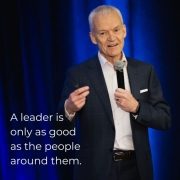How to Fix an Accountability Problem on Your Team
“Everyone on a team knows who is and who is not performing,
and they are looking to you as the leader to see
what you are going to do about it.”
The late Collin Powell,
Former US Secretary of State
How many times in the past year have you heard, “We need more accountability on our team?”
When you’re frustrated and things aren’t going well — maybe your numbers are down, or people aren’t showing up the way you need them to, or team members aren’t meeting your expectations — it’s easy to turn to this all-too-common refrain. But when you announce that you “need more accountability here” what your team actually hears is: “You’re failing, and it’s your fault.”
No one is inspired by being blamed. While there may be times when your team could put in a more focused effort, a lack of accountability is rarely intentional. Any lack of accountability is a downstream problem that requires upstream action. It’s always better to prevent pollution than to clean it up. Leaders who default to a plea for accountability will inevitably hit a wall of frustration.
Further, verbalizing that there is “a lack of accountability” on your team can easily come off as threatening or condescending to people on the receiving end. This is hardly productive when you are trying to inspire change, and more importantly, it doesn’t help you get to the root of the problem.
Rarely is an accountability problem actually an accountability problem. It’s an agreement problem. The way you fix it is through a better agreement process:
- Clarify your expectations. Ambiguity breeds mediocracy. It also breeds frustration. Clearly communicate the measurable results you expect, including the kind of behavior that demonstrates your values.
- Create a compelling WHY. People need to understand how what you expect from them makes a meaningful impact toward the overall success of the organization and the people you serve.
- Assess fit. Be sure that people are passionate about what you expect from them, and that it lies in their wheelhouse of strength. Accountability without an element of passion is drudgery. Leaders are accountable to ensure that you have the right people on the team.
- Aim high. Expect high standards, both for yourself and others. Challenge yourself and those under your care with lofty goals, a commitment to results, and high expectations so everyone will grow and feel great about themselves at the end of the project.
- Get an agreement. A request is not an agreement. Be sure to get a clear yes to your request to deliver expected results. Every defined expectation needs to end with, “Can I count on you?”
- Clarify support requirements. Aside from a lack of understanding the expectations, people fail to perform as expected when they lack the required skill or capacity. Leaders are accountable to assess workplace competencies and ensure adequate resources are available. Ensure the person you have expectations of feels supported.
- Identify consequences. Clarify what the results will be for delivering on your promises – to the individual and to the organization. What’s important to the individual? What’s important to the organization? Negotiate a win-win relationship. And sometimes, especially if you’ve made a mistake around fit, help people make a career decision and move on from their role.
- Have an evergreen plan. Map out a process for keeping your agreements to each other current and useful. How often do you need to meet to review expectations? Be sure to have a clear process for tracking and measuring success and how you will discuss it when your expectations of each other are not being met.
When you are promoted, you don’t get more power, you get more accountability to assess and implement the accountability process. Any accountability problem on your team is corrected by being accountable. Just as blame is never a good strategy, pleading for more accountability isn’t the answer either. Those who develop self-awareness, clarity, empathy, and courage to have the tough conversations will create powerful solutions, build winning teams, and create workplaces where people are inspired.
If you want to be an authentic leader that people want to work with, shift your mindset from blame to ownership, assess the gaps, and practice filling the gaps with these eight strategies. You’ll drive better results, make lasting impactful change, reduce your frustration, and create unstoppable workplaces.









